|
|

We Monferrini | Our
Stories | Monferrino Diary | History
| Language |
Gallery
Our Names | Family
Album | Links | Bibliography
| Turismo | Guestbook| Pagine Monferrine
Storia
del Monferrato
A Woodstock dress rehearsal ... in Monferrato
Few know or remember that in the summer of 1969, a little before man stepped foot on the moon, San Salvatore Monferrato was invaded by a peacceful horde of hippies from across Italy and Europe enjoying themselves in the days before the biggest musical event of the era: Woodstock.
Musicians of the caliber of Joan Baez, Jimi Hendrix, Janis Joplin, Canned Heat, Crosby Stills Nash & Young, and others arrived, incognito, at San Salvatore. It was an unpublicized rehearsal, already forgotten and now brought to light again by a young director from the Monferrato, who now lives in Milan, named Giulia Torra.
Check out her amazing video about the event here.
Reportage dalla visita ai colossi genealogici mondiali e alla nuova frontiera
delle ricerche sul DNA.
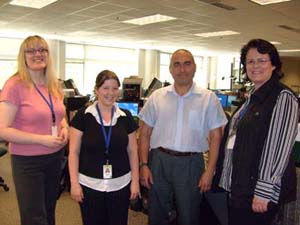
Scrivo di ritorno dal recente viaggio negli Stati Uniti, nello Utah, volto a esplorare nuovamente, a dieci anni dalla mia prima visita, la realta' dei grandi colossi genealogici mondiali: FamilySearch (che fa capo alla Chiesa Mormone) e The Generations Network. I loro referenti in Italia, rispettivamente i sigg. Zafarana e Cole, avevano recentemente presentato al convegno di Omegna numeri che davano l'ordine di grandezza dei loro archivi: miliardi di nominativi e di immagini disponibili per la consultazione (sia gratuita, sia a pagamento) riguardanti registrazioni di vario tipo (nascite, matrimoni, decessi, registri, atti di vario tipo).
Via Internet o presso le loro sedi e' possibile quindi effettuare ricerche sulla storia della popolazione mondiale. Particolarmente bene organizzata e' la Library dei Mormoni a Salt Lake City, disposta su piu' piani, con postazioni di terminali, libri, scrivanie, lettori di microfilm, in grado di accogliere un gran numero di ricercatori, come si vede nella foto che mi ritrae con una responsabile del posto.
Pare che i piu' assidui frequentatori siano i discendenti di emigrati di origine germanica.
Il 23 giugno sono presso i Mormoni a Salt Lake City; trovo ad attendermi la sig.a Ruth Lapioli Merriman e il sig. Keith Rose con i quali ho modo di presentare il Metodo Ferro, per fortuna in italiano, vista la complessita' dei temi da trattare. Da 5 anni i loro ingegneri stanno lavorando a un progetto per ottimizzare le informazioni presenti nei molti alberi genealogici che hanno ricevuto. Al momento e' quindi impossibile per loro cambiare, ben riconoscendo la validita' del mio metodo.
Il 24 giugno sono da The Generations Network. Mi devo presentare all'ingresso della TGN presso il reception desk verso le 13.45. L'indirizzo e' 360 W 4800 N, ci sono due edifici collegati fra di loro con due ingressi, quello verso East e' chiuso e quello verso West (sulla sinistra con il parking lot alle spalle) e' aperto. La corrispondente con la quale sono in contatto da tempo la sig.a Paola Manfredi mi ha fissato un appuntamento insieme alla sig.a Suzanne Russo Adams e al sig. Shawn Reid, due manager della TGN. Anche a loro tre, fortunatamente in italiano, presento il mio metodo. Segue poi una interessante visita ai locali della TGN. Mi dicono che i dipendenti ruotano su 3 turni, si lavora 24 ore filate, hanno macchine che fotografano in automatico migliaia di pagine di libri al giorno. Usano tecniche in grado di leggere scritture poco visibili; in queste operazioni di indicizzazione dei molti documenti riprodotti in digitale, o su microfilm, utilizzano anche manodopera cinese. Essi riescono comunque a leggere la scrittura per loro poco familiare con buoni risultati. A trattare in prima battuta i file contenenti le riproduzioni che giungono da ogni parte nel mondo vi sono dipendenti di madrelingua italiani, francesi, tedeschi, ecc. che seguono le varie areee geografiche.
Operativamente TGN raggruppa vari marchi presenti sul web: Ancestry.com, Myfamily.com, Rootsweb.com, Genealogy.com e Family Tree Maker. L'azienda, privata, conta su circa 800.000 abbonati all'anno i quali comprano password di consultazione di vari livelli, a seconda della quantita' di informazioni che si possono ottenere.
Sempre presso la TGN effettuo pure il test del DNA. Infatti durante la mia permanenza nel continente americano ho avuto modo di recarmi anche presso il laboratorio Sorenson and Genomics, sempre a Salt Lake City, specializzato nella ricerca sul DNA alla scoperta delle origini ancestrali dei nostri antenati vissuti milioni di anni fa.
Parlo con il sig. Mouritsen, un responsabile, il quale mi introduce nell'argomento, invitandomi pero' a prendere contatto con il sig. Ugo Perego, col quale, in italiano, ho modo via mail di approfondire meglio i concetti. Confesso che sono in attesa, con non poca curiosita', dei risultati.
Chi volesse effettuare il test dall'Italia lo puo' fare raccogliendo un po' della propria saliva con dei semplici cotton fioc da richiedere tramite la "Dna Ancestry", 193 South Mountain Way Drive, Orem, Utah 84058 e poi spedire al 2495, South West Temple, Salt Lake City, Utah 84115.
Dalla comparazione dei risultati presenti nelle loro enormi banche dati e' possibile conoscere, con un elevato grado di probabilita', da quale gruppo ancestrale proveniamo.
Tutte queste attivita' sono fondamentali per le ricerche genealogiche, specialmente per il Piemonte.
L'Italia, e nello specifico il Piemonte, ha avuto nei secoli scorsi un numero molto elevato di emigrati i cui discendenti abitano oggi in varie parti del mondo e sovente richiedono notizie sui loro lontani parenti partiti alla ricerca di un futuro migliore. Tutto quanto facciamo ha quindi un grande valore per facilitare il reperimento di informazioni utili. --Silvano Ferro
Is your family from Cercenasco?
Mariagrazia Alliaudi and Silvio Genero, from Italy, are researching on Cercenaschesi (people from Cercenasco, a village in the Province of Turin) who emigrated to Texas and Argentina at the end of the 19th century. The Cercenasco City Council has charged them with the task of writing a book on the subject.
The two researchers are interviewing all the families in Cercenasco who had ancestors that emigrated and their aim is to analyze the communities formed in America. They are especially in the family stories both in Texas and Argentina, as well as in their family trees and old photos. If you have relatives who were from Cercenasco and who settled in Texas or Argentina, please contact Silvio Genero at silviogenero@tele2.it. And tell him the Monferrini in America sent you!
Ex votos at Crea
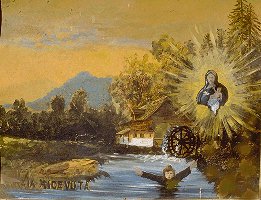 Go to any church in Italy and you will find ex votos giving thanks to God, the Madonna or saints for their assistance in answering prayers. The result of the generations of tributes rendered by the faithful is that ex votos are a plentiful source of folk art across the country. Go to any church in Italy and you will find ex votos giving thanks to God, the Madonna or saints for their assistance in answering prayers. The result of the generations of tributes rendered by the faithful is that ex votos are a plentiful source of folk art across the country.
In the Monferrato it is no different, of course, and a place like the Sacred Mount at Crea will have an extremely rich ex voto tradition. Usually, the only way to see these paintings and other art works is to travel to the region's churches.
But now, thanks to the Internet, you can see many ex votos without ever leaving home (although, we're always looking for an excuse to travel to Italy, so we don't expect that this service will quash our desire to be there).
To see a selection of ex votos from Crea, including detailed information on their subject matter, their state of preservation and more, click here. Searching the Web for ex votos will turn up more results, too.
La storia della Fiera del Tartufo
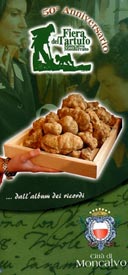 Quando arriva l'autunno, alla fine del mese di ottobre, Moncalvo offre ai buongustai e ai turisti un appuntamento che ormai si compie da mezzo secolo: la Fiera del Tartufo. Quando arriva l'autunno, alla fine del mese di ottobre, Moncalvo offre ai buongustai e ai turisti un appuntamento che ormai si compie da mezzo secolo: la Fiera del Tartufo.
La manifestazione ebbe inizio, come idea, a Moncalvo quando, all'inizio del Novecento, Pietro Lanfrancone, proprietario di una locanda dove si incontravano i trifulau il giovedi' di ogni settimana per il mercato, essendo un estimatore e finissimo intenditore di tartufi, organizzo' di fatto la prima mostra concorso. Scegliendo una giuria tra i "trifulau" stessi, faceva esaminare gli esemplari, custoditi nei tradizionali fazzoletti di cotone a quadroni blu, poi premiava i piu' belli singolarmente, ed il gruppo piu' abbondante.
Il premio era costituito da un invito a pranzo per i fortunati cercatori il giovedi' successivo. Questo cerimoniale si svolgeva gia' allora la terza domenica di ottobre (data storica) e continuo' cosi' fino al 1955. In quell'anno il Comune trasformo' questa "festa tra amici" in un Concorso del Tartufo di Moncalvo e del Monferrato.
La sua sede divento' l'antico, stupendo porticato che delimitava il castello che resta ancora oggi, con qualche cambiamento dettato da nuove esigenze, il palcoscenico e la cornice dell'evento e da' continuita' alla tradizione.
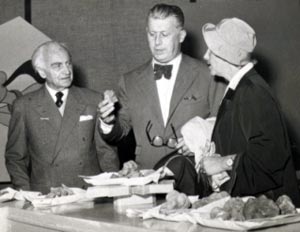 Successivamente la denominazione "concorso" cambiera' per diventare "fiera" e negli anni '60 e '70 la manifestazione prendera' una connotazione precisa. In quegli anni la quantita' di tartufi presenti sui tavoli per affrontare il giudizio della giuria e' qualche cosa di sconvolgente per abbondanza e qualita'. La natura non ha ancora posto i gravissimi condizionamenti ambientali che negli anni successivi ridurranno in modo drastico il raccolto. Si pensi che all'epoca era possibile ammirare esemplari di un chilogrammo. Il regolamento imponeva che i tartufi esposti dovessero pesare non meno di mezzo chilo. Successivamente la denominazione "concorso" cambiera' per diventare "fiera" e negli anni '60 e '70 la manifestazione prendera' una connotazione precisa. In quegli anni la quantita' di tartufi presenti sui tavoli per affrontare il giudizio della giuria e' qualche cosa di sconvolgente per abbondanza e qualita'. La natura non ha ancora posto i gravissimi condizionamenti ambientali che negli anni successivi ridurranno in modo drastico il raccolto. Si pensi che all'epoca era possibile ammirare esemplari di un chilogrammo. Il regolamento imponeva che i tartufi esposti dovessero pesare non meno di mezzo chilo.
Nel 1973, per delibera comunale, l'organizzazione della Fiera (fino ad allora curata dalla Pro Loco) viene affidata ad una commissione di esperti guidata dal Presidente, di nomina consigliare.
Le domeniche di festa diventano due, fissate nella penultima e ultima domenica di ottobre di ogni anno. La piazza si anima con stand ricchi di prodotti dell'enogastronomia tipica del territorio e abbellita coreograficamente dalle opere di Mario Pavese, sensibilissimo artista e abile grafico moncalvese che crea e brevetta per la fiera il marchio che ancora oggi la identifica nel mondo.
Oggi la Fiera del Tartufo di Moncalvo e' una realta' con radici salde.
Si puo' dire, senza peccare di presunzione, che e' uscita dai confini geografici naturali dopo una crescita maturata nel tempo. Lo dimostrano le 30.000 presenze, che aumentano ogni anno e l'interesse che sa suscitare per essere diventata non solo un importante elemento trainante dell'economia locale, ma anche un appuntamento di forte interesse turistico e culturale, grazie a una serie di manifestazioni che sono corollario alle giornate del tartufo.
Se questa e' la realta' dei tempi d'oggi, Moncalvo ha pero' alle spalle una "storia profumata al tartufo" lunga almeno 500 anni.
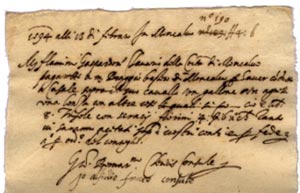 Ne abbiamo testimonianza in un documento conservato nell'Archivio Storico comunale datato 1594. E' esattamente una fattura di pagamento per il trasporto di: "un gallone, un agnello, una lonza e otto libbre di trifole (circa 4 kg) con seraci (forme di ricotta)". Ne abbiamo testimonianza in un documento conservato nell'Archivio Storico comunale datato 1594. E' esattamente una fattura di pagamento per il trasporto di: "un gallone, un agnello, una lonza e otto libbre di trifole (circa 4 kg) con seraci (forme di ricotta)".
Dunque a Moncalvo nel 1594, i tartufi c'erano! Dato incontestabile. Una copia di questo prezioso documento e' esposta nel Ristorante Barbetta di New York della fubinese Laura Maioglio, che nel novembre 2000 ospito' una rappresentanza della Amministrazione comunale.
Per celebrare il cinquantesimo compleanno della sua Fiera, la Commissione municipale che gestisce la manifestazione ha pubblicato un libretto, distribuito gratuitamente, che racconta in breve la storia del concorso-esposizione, con molte fotografie d'epoca, dagli anni '50 quando il regista della fiera era il senatore e letterato Vincenzo Buronzo ("brace odorosa, rosa focosa" egli defini' il tartufo monferrino), agli anni '60 e '70 che videro l'esemplare piu' bello di tartufo donato agli astronauti che conquistarono la Luna, e fino alle edizioni piu' recenti, con illustri ospiti tra i banchi a gustare l'aroma del profumatissimo tubero.
I testi di Angela Strona, abile e determinata presidente della Commissione, illustrano i momenti salienti e le caratteristiche della manifestazione moncalvese, che ora attende l'edizione numero 51, nel 2005.
--Alessandro Allemano
Palio
d'Asti films take you back in time
Revisit Asti in the 1960s with these two clips, filmed during
the Palio d'Asti in the 1960s by Sebastiano Frixa of Treville and submitted to Monferrini in
America by his son Alfredo
Frixa. Click each photo download the mpeg files, which require a viewer
such as Quick Time.
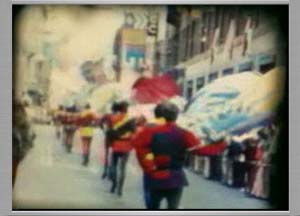 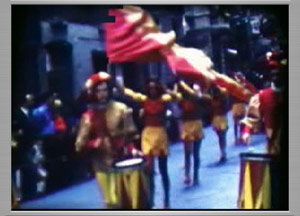
A
document from the Monferrato's
Jewish past
Moncalvo, like many Piemontese towns and cities, once
had a large Jewish community. This letter, recently found on the
Internet, is from 1856 and is on stationery of Moncalvo's Commissione
Israelitica. It is a remnant of a sadly vanished time and community.
For more, visit the We Monferrini page of this site, where there
is a short description of the synagogue in Casale Monferrato.

Astigiani,
Fubinesi and other Monferrini
in New York
Like
Italians from all over the boot, Monferrini, upon arriving in America,
were quick to set up mutual aid societies to help pay for life's
tragedies (sickness, inability to work, death), religious organizations
and social clubs. The Fubinese Society was founded in the 1920s
and had hundreds of members who hailed from Fubine. The society
was so successful that for years it had its own building in midtown
Manhattan, in the heart of the West Side (aka Hell's Kitchen) Piemontese
community. The society still exists holds an annual dinner each
autumn. Sadly, the building was sold many years ago.
Emigrants from Asti also kept alive traditions and every year the
Astigiani would celebrate the feast of Asti's patron saint San Secondo
with a dinner. Click here to see read
the text (in Italian; translations will come) of 1920s newspaper
articles about the events. Thanks to Giancarlo Libert for the articles.
There was also a Casorzese society, one for emigrants from Castell'Alfero
and La Monferrina, which met and held society affairs at Mazzini
Hall, across the river in New Jersey. |
| 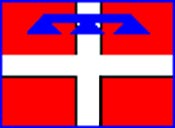 The
story of the Piemontese flag... The
story of the Piemontese flag...
The
official flag of the region, adopted on the 24th November 1995,
is red bordered white (thin) and blue with a white cross charged
on top with a blue lambel. Sometimes there is a blue border, sometimes
not.
Read all about
the different flags used over the centuries and about how this one
came to look like it does. Click here.
|
|
Here's
what Encyclopedia.com
says about the Monferrato...
Montferrat montfrat, -rĘt , Ital. Monferrato, historic
region of Piedmont, NW Italy, south of the Po River, now mostly
in Alessandria prov. It is largely hilly, and wine, fruit, and cereals
are produced. In the late 10th cent. Montferrat was created a marquisate
held by the Aleramo family, and its rulers played an important role
in the Crusades. In 1310 it passed to the Paleologo family. Casale
became the capital of the marquisate in 1435. With the extinction
of the Paleologo line, Emperor Charles V gave (1536) Montferrat
to the Gonzaga family of Mantua, despite the claims of the house
of Savoy. After Francesco Gonzaga's death in 1612, Savoy renewed
its claims on Montferrat and invaded (1613) the region. Spain and
France intervened. The Treaty of Cherasco (1631) assigned parts
of Montferrat to the house of Savoy, and the rest (including Casale)
followed the fortunes of the duchy of Mantua and passed to the Nevers
(French) branch of the Gonzaga family. All of Montferrat was recognized
by the Peace of Utrecht (1713) as belonging to the house of Savoy.
Follow the leaders... Click here
to see who ruled the Monferrato from Aleramo in 967 through the
House of Savoy under which Italy was united circa 1860-'70 and which
ruled the country until the republic won out after World War II.
How
Aleramo obtained the Marquisate of the Monferrato...
In 1330, a friar named Jacopo da Acqui
recorded the story, later taken up by others, of the Emperor Otto
I, who in order to thank Aleramo for services rendered, proclaimed, "All the lands that lie between Piedmont and the sea that you
can cover riding for three days will be yours and on them you will
found your marquisate." There is some argument as to the validity
of this story, but you must admit, it's a nice one. By the way,
Aleramo had by that time also fallen in love with Otto's daughter
and run away with her against her father's wishes, so Otto
must also have been a forgiving ruler (or one with an ulterior motive).
Aleramo is buried in the nave of the abbey at Grazzano Badoglio.
On emigration, from Piemontesi Nel Mondo...
More than two million Piedmontese people emigrated
from 1870 to 1970, the year when their exodus definitively stopped.
Those who are of Piedmontese origin are four million, which means
that more than six million Piedmontese live throughout the world
today.
PIEDMONTESE EMIGRATION FROM 1876 TO 1900 (FIRST PHASE)
The year 1876 does not really mark the beginning of emigration,
rather the official recording of the phenomenon. While Italian emigration
was sharply increasing those years, the Piedmontese one was not
following suit, it was in fact fluctuating; the phenomenon then
grew considerably during the eighties and the nineties. As far as
the favourite destinations during the first 25 years are concerned,
France was placed at the top of a hypothetical list, followed by
Argentina, Brazil and the U.S.A. Piedmontese emigrants who moved
to the biggest cities of Argentina applied themselves to any kinds
of job: they worked mainly as farmers, farmhands, craftsmen and,
to a smaller extent, as professionals, teachers, artists and dealers.
The migratory movement to Brazil began soon after the abolition
of serfage. Just like in Argentina, Piedmontese emigrants who moved
to Brazil were almost all farmers or farmhands, but there was also
a considerably growing number of priests coming from a Turin-based
Salesian Mother House. Some people even moved to Australia. Piedmontese
emigrants had to cross as many as three oceans to reach this country:
the Atlantic, the Indian and the Pacific Ocean. The first golddiggers
from northern Novara boarded mainly at Hamburg in the first half
of the nineteenth century, but someone also boarded the ship at
the English ports of Liverpool and Plymouth. The second migratory
movement from Piedmont to Australia, which took hundreds and hundreds
of emigrants to the sugarcane plantations of Queensland tropical
lands, used a different route: they crossed the Red Sea owing to
the Suez Canal, which had been opened in 1869, and they stopped over at the Isle of Columbus, that is present-day Sri Lanka. A lot
of Piedmontese had to cross for thousands of miles to find a permanent
job and have a serious affair. Before 1891, which experts define
as a crucial year for Queensland demographic development, Piedmontese
emigrants came especially from the province of Turin and Cuneo and
moved above all to the biggest cities of Southern Wales, Victoria
and, to a smaller extent, to Western Australia.
PIEDMONTESE EMIGRATION FROM 1901 TO 1913 (SECOND PHASE)
As it is widely known, a great number of Italian emigrants came
from the region of Piedmont. At the beginning of the twentieth century
10,000 (more than 25%) people out of 39,000 who moved to France
were Piedmontese. In 1905 the proportion reached 31.03%, as 19,000
out of 58,000 were Piedmontese; In the pre-war period the ratio
reached the peak when the Piedmontese were 41.66% out of 36,000
Italians recorded abroad. Cuneo was the Italian most represented
town with 62.2% of emigrants. Furthermore, more and more women took
part in the migratory movements, which was a sign of both a greater
number of family units and the beginning of women independent emigration.
In the first years of the twentieth century Piedmontese emigration
was quite unsteady, even though influenced by a rising trend. As
many as 752,531 people emigrated between 1901 and 1913: 59% of them
moved towards Europe, whereas 41% of them moved to overseas countries.
As far as Europe is concerned, France absorbed most Piedmotese emigrants,
followed by Switzerland, Germany and Austria. Among the overseas
countries the record was held by Argentina, followed by Brazil and
the U.S.A. Claudio Pizzelli, President of the Federation of Piedmontese
people in Brazil as well as consular correspondent of the town of
Osasco, told, " In the first years of the twentieth century, a textile
factory of Biella was moved to the suburbs of San Paolo. It was
called "Italbrasil" and helped the development of a burgeoning textile
industry. As the factory was established in a hill area and the
climate was suitable, many workers started making Piedmontese wines
in their free time. Wine gradually became a very important resource
and today that area is still known as the 'land of wine' , in spite
of the reduced interest of new generations". A great number of Piedmontese
were absorbed by Australia as well. In the areas of sugarcane plantations
their number reached such a high percentage to even represent the
greatest Italian ethnic group. That was the time of migratory movements
from Alessandria and Asti: hundreds of people left their villages
on hills, which were all vineyards, to move to towns with names
they often did not even know. The jobs that emigrants did in this
period were not really different from the ones of the previous period;
a slightly higher number of qualified workers, however, added to
farmers and the other workforce due to the growing popularity of
the U.S.A as favourite destination.
PIEDMONTESE EMIGRATION FROM 1914 TO 1918 (THIRD PHASE
The outbreak of the First World War and consequent financial difficulties
were two of the major checks to the migratory movement. The state
of departures from Piedmont, however, was not really different from
the one of the past. Even though it was slightly decreasing, the
migratory movement towards the rest of Europe was still rather thick
owing to the possibility to easily reach the two nearest outlets
which stayed open all war long, that are France and Switzerland.
The new important aspect of the migratory movement of the years
of the First World War was that more than 60% of emigrants were
women, whereas in the past, according to the tradition, about 70-80%
of them were men. In the post-war period a lot Piedmontese left
their country not due to a need, but just for their spirit of adventure.
Australia particularly embodied the attracting promising exotic
dream of eternal youth, and the support of some relatives who had
already settled in the different States of the Australian Confederation
encouraged emigrants to leave their belongings and their families.
PIEDMONTESE EMIGRATION FROM 1919 TO THE '70s
Soon after the end of the war, a crisis of transports by sea came
to hinder the wish to emigrate. This was only a transitory problem,
but was followed by the outbreak of the Depression which struck
all the countries where Italian emigrants had some chances to find
a job; nevertheless emigration did not stop. It is possible that
the four historical phases of emigration were followed by a "fifth
phase", which went on till the Second World War. The years between
1930 and 1942 were marked by a violent policy against emigration
and a consequent low percentage of emigrants, who moved mainly across
Europe. The end of the Second World War then opened a "sixth phase",
which went on, though with changing fortunes, till 1970. The emigration
of this period was quite different from the great exodus of the
twenties and thirties: people were generally invited by relatives
or friends who had settled abroad. Sometimes some people were even
forced to expatriate for political reasons: those who were compromised
due to Fascism or played a wrong role during the war of liberation
are good examples. The fifties and the sixties were the time of
rational expatriation, which involved people with a good education,
such as technicians and restaurateurs holding a professional diploma.
Owing to this new kind of emigration Piedmont cuisine became famous
throughout the world. In America Italians distinguished themselves
by working with their feet and their hands to build great cities.
The stories of Italian people who moved to overseas countries can
outline a positive consequence of emigration, that is the strong
capability of emigrants to survive, though dearly, in far foreign
countries and keep being attached to their origins. Those people
who managed to go far, however, started by working someone else's
land, building railroads and picking coffee in sunny huge fazendas;
anyway, they never forgot their native land. |
Don
Ernesto Camurati and the tragedy at Villadeati
Piemonte was one of the most dedicated strongholds of the Italian
Resistance during World War II and, as a result, it paid a high
price in human and other sacrifice at the hands of the Germans.
On 9 October 1944, the Nazis arrived in Villadeati, where they
plundered much of the town and set it on fire. The men of the
town were assembled in the piazza and nine were sentenced to die
by firing squad. The parish priest Don Ernesto
Camurati offered his life in exchange for those of his townsmen,
but he was murdered along with the nine men. Click the links below
to read a PDF file of what Casale's Il Monferrato wrote about
Don Camurati in its "Un Secolo di Monferrato 2000." Page
1 | Page 2 | English
version
Visit Il Monferrato's web
site, which offers a wealth of information on the area.
For more on the Resistance in Piemonte, click here
to read about Divisione Mingo and here
to visit th web site of the Institute for the History of the Resistance
and Contemporary Society in the Province of Alessandria.
|
|






 Go to any church in Italy and you will find ex votos giving thanks to God, the Madonna or saints for their assistance in answering prayers. The result of the generations of tributes rendered by the faithful is that ex votos are a plentiful source of folk art across the country.
Go to any church in Italy and you will find ex votos giving thanks to God, the Madonna or saints for their assistance in answering prayers. The result of the generations of tributes rendered by the faithful is that ex votos are a plentiful source of folk art across the country. Quando arriva l'autunno, alla fine del mese di ottobre, Moncalvo offre ai buongustai e ai turisti un appuntamento che ormai si compie da mezzo secolo: la Fiera del Tartufo.
Quando arriva l'autunno, alla fine del mese di ottobre, Moncalvo offre ai buongustai e ai turisti un appuntamento che ormai si compie da mezzo secolo: la Fiera del Tartufo.  Successivamente la denominazione "concorso" cambiera' per diventare "fiera" e negli anni '60 e '70 la manifestazione prendera' una connotazione precisa. In quegli anni la quantita' di tartufi presenti sui tavoli per affrontare il giudizio della giuria e' qualche cosa di sconvolgente per abbondanza e qualita'. La natura non ha ancora posto i gravissimi condizionamenti ambientali che negli anni successivi ridurranno in modo drastico il raccolto. Si pensi che all'epoca era possibile ammirare esemplari di un chilogrammo. Il regolamento imponeva che i tartufi esposti dovessero pesare non meno di mezzo chilo.
Successivamente la denominazione "concorso" cambiera' per diventare "fiera" e negli anni '60 e '70 la manifestazione prendera' una connotazione precisa. In quegli anni la quantita' di tartufi presenti sui tavoli per affrontare il giudizio della giuria e' qualche cosa di sconvolgente per abbondanza e qualita'. La natura non ha ancora posto i gravissimi condizionamenti ambientali che negli anni successivi ridurranno in modo drastico il raccolto. Si pensi che all'epoca era possibile ammirare esemplari di un chilogrammo. Il regolamento imponeva che i tartufi esposti dovessero pesare non meno di mezzo chilo.  Ne abbiamo testimonianza in un documento conservato nell'Archivio Storico comunale datato 1594. E' esattamente una fattura di pagamento per il trasporto di: "un gallone, un agnello, una lonza e otto libbre di trifole (circa 4 kg) con seraci (forme di ricotta)".
Ne abbiamo testimonianza in un documento conservato nell'Archivio Storico comunale datato 1594. E' esattamente una fattura di pagamento per il trasporto di: "un gallone, un agnello, una lonza e otto libbre di trifole (circa 4 kg) con seraci (forme di ricotta)". 


 The
story of the Piemontese flag...
The
story of the Piemontese flag...